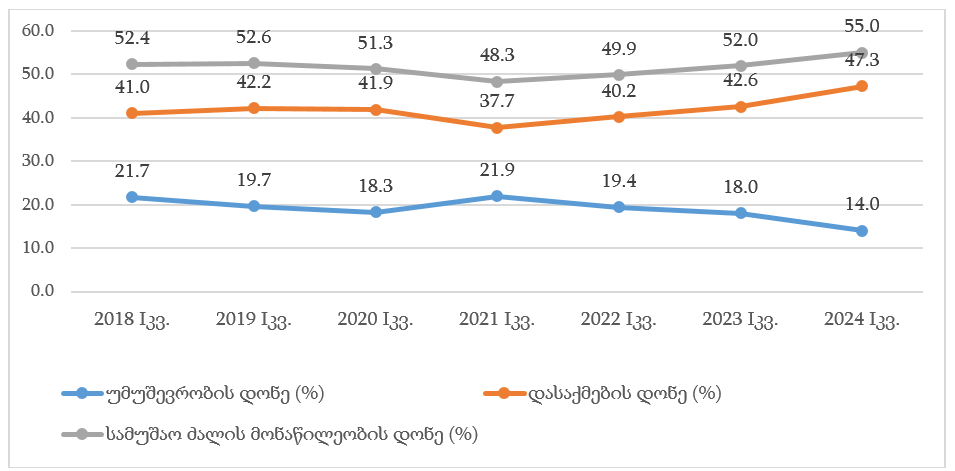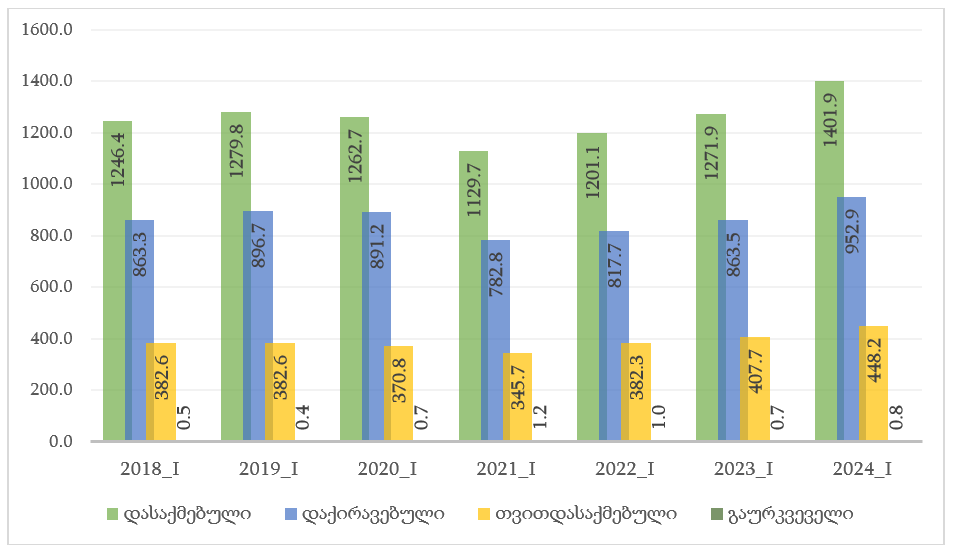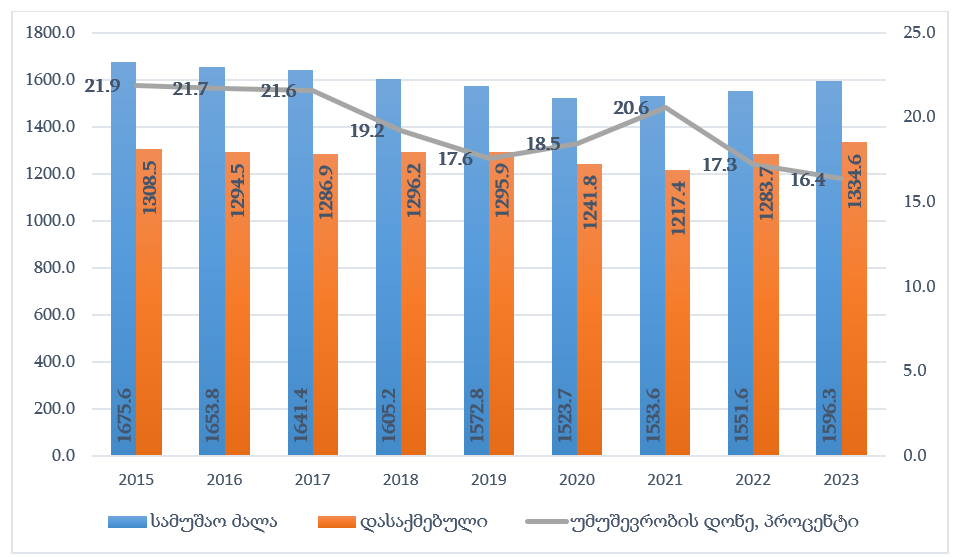Irakli Kobakhidze: “A total of 1.4 million people are currently employed in Georgia, marking a record high since the 1990s.”
Verdict: FactCheck concludes that Irakli Kobakhidze’s statement is MOSTLY TRUE.
The unemployment rate reached 14%, constituting a four percentage-point decline in the first quarter of 2024 as compared to the same period last year, according to GeoStat data.
The number of employed individuals increased by 130,000 (10.2%) in the first quarter of 2024 as compared to the same period last year, reaching a total of 1.4 million. The employment rate increased by 4.7 percentage points, reaching 47.3% over the same period.
Whilst it remains undetermined whether or not this number is a record high since the 1990s, as quarterly data of employment indicators have only been researched since 2018, the current data suggests that the total number of employed individuals and the employment rate surpass the previous records from 2018 to 2024 for the same quarter. The highest figures of the labour force were recorded in 2023 as per the data from 2010 to 2023 when analysing annual statistics.
The labour force in Georgia has exhibited a declining tendency since 2015. It decreased by 102,800 from 2016 to 2019, whereas the number of employed people decreased by 12,600. Furthermore, the employment rate decreased due to the diminishing economically active population without an actual rise in employment. The employment/unemployment rates significantly worsened in the pandemic period of 2020-2021. However, the employment rate has improved from 2022 onwards due to some underlying factors: the recovery of lost jobs during the pandemic, the creation of new employment opportunities alongside economic growth and increased employment in the public sector, including the employment of socially vulnerable individuals in public jobs, etc.
Analysis
Prime Minister Irakli Kobakhidze presented the annual report at the Parliament on 28 June, discussing various topics including the labour force. He highlighted the unemployment rate, stating: “Comparing the first quarter of the current year to that of the previous year, the unemployment rate has decreased by four percentage points from 18% to 14%. An additional 130,000 individuals are now employed, contributing to a record high employment. A total of 1.4 million people are currently employed in Georgia, marking a record high since the 1990s.”
The unemployment rate is calculated as the ratio of unemployed individuals to the economically active population (labour force). The unemployment rate reached 14%, constituting a four percentage-point decline in the first quarter of 2024 as compared to the same period last year, according to GeoStat data. The number of unemployed individuals decreased by 50,600 (18.1%), bringing a total of 228,600 economically active individuals who are not currently employed but actively seeking employment. To clarify, an individual over the age of 15 who is neither employed nor seeking employment (has not sought a job in the four weeks prior to being surveyed) is considered to be outside the labour force and is thus excluded from the unemployment figure. The number of individuals outside the labour force exceeded 1.3 million in the first quarter of 2024.
The employment rate increased by 4.7 percentage points, reaching 47.3% in the first quarter of the current year as compared to the same period last year. The labour force participation rate (the labour force as a percentage of the total population over the age of 15) rose from 52% to 55% (refer to Graph 1).
Graph 1: Labour Force Data from 2018 to 2024 (Data of the First Quarters)

Source: National Statistics Office of Georgia
The number of employed individuals increased by 130,000 (10.2%) in the first quarter of 2024 as compared to the same period last year, reaching a total of 1.4 million. The number of hired employees rose by 89,400 (10.4%) whilst the number of self-employed individuals increased by 40,500, constituting a 9.9% rise (refer to Graph 2).
Employment has reached a record high, according to the Prime Minister. Quarterly statistics of labour force variables have only been recorded since 2018, hence it is impossible to make comparisons to earlier data. The current data indicates that the total number of employed individuals and the employment rate surpass the previous records from 2018 to 2024 for the same quarter.
Graph 2: Number of Employed Individuals from 2018 to 2024 (Data of the First Quarters)

Source: National Statistics Office of Georgia
We analysed annual employment and unemployment data to evaluate long-term trends as quarterly data prior to 2018 is unavailable. However, comparisons to the period before 2010 are not relevant even with this approach due to the different methodology that was previously used to record labour force indicators.
Notably, employment and unemployment statistics from 2010 to 2024 follow the updated and approved standards set by the International Labour Organisation (ILO). Whilst the employment rate was substantially higher prior to 2010, this is due to the different methodology used to calculate unemployment. A considerable portion of self-employed individuals engaged in household production without salaries were recorded as employed under the old methodology for technical reasons. The new methodology reclassified the aforementioned category, resulting in a striking decline in the percentage of the employed population.
Labour force indicators (the labour force, employment, the unemployment rate) improved from 2010 to 2015. However, the labour force (individuals who are currently employed or seeking employment) decreased in 2015, leading to a lower employment rate. Furthermore, the labour force decreased by 102,800 from 2016 to 2019, whereas the number of employed individuals experienced a decrease of 12,600 over the same period. The unemployment rate decreased from 21.9% to 17.6% due to the diminishing economically active population, without an actual rise in employment.
The employment/unemployment indicators substantially deteriorated in 2020-2021 due to the severe and prolonged restrictions in the economy during the pandemic. Whilst the employment and labour force metrics improved in 2022, the figures had not yet returned to pre-pandemic marks.
Both the economically active population and employment indicators improved in 2023 whilst the unemployment rate decreased from 17.3% to 16.4%. The aforementioned employment indicators not only experienced a positive tendency as compared to the previous year but also exceeded the pre-pandemic rates.
Graph 3: Labour Force Indicators from 2015 to 2023

Source: National Statistics Office of Georgia
Thus, a percentage of the economically active population has exhibited a positive tendency since 2015, contributing to a decrease in the unemployment rate despite no substantial increase in employment. The unemployment and employment rates worsened during the pandemic years of 2020 and 2021. However, employment metrics significantly improved in 2022 and 2023, leading to a declining unemployment rate. The positive trajectory has remained in the current year.
The lifting of the economic restrictions following the end of the pandemic contributed to the recovery of jobs lost during the pandemic. Subsequently, employment saw an increase due to the creation of new employment opportunities, increase in public sector employment and artificial job creation due to the expansion of the economy. The number of employed individuals in the public sector reached a record high in 2023. Furthermore, the state budget has been funding a programme for socially vulnerable individuals since 2022, ensuring their employment in artificially created public sector jobs.
The number of employed individuals totalled 1.4 million in the first quarter of the current year whilst the employment rate constituted 47.3%, surpassing the data from the first quarters of 2018 to 2024. The most positive figures of employment indicators (total number of employed individuals, employment rate) were recorded in 2023 when analysing annual data of the period from 2010 to 2023. It is not possible to determine whether or not the aforementioned employment rate is a record high since the 1990s due to the absence of relevant data from previous time periods.









